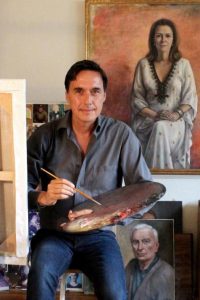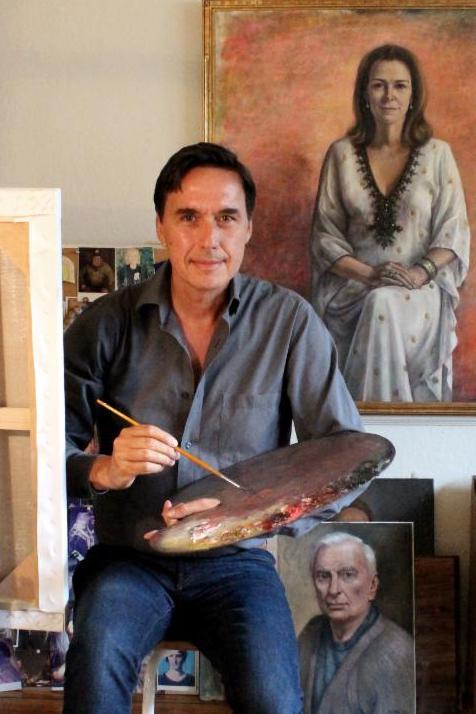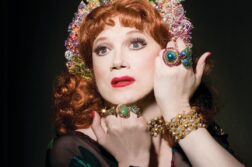JUAN BASTOS is a portrait painter whose work was on exhibit at a major retrospective at the Denenberg Fine Arts Gallery in West Hollywood, CA, in November. Included in the exhibition were the covers of several issues of The Gay & Lesbian Review that featured Juan’s art.
 I had a lively conversation with Juan about his career as an artist and about the exhibition, which was part of the massive Getty Museum project, Pacific Standard Time: LA/LA, a celebration of Latin American art in Southern California, with dozens of galleries participating. Juan’s covers for The G&LR, of which there were a dozen in the early 2000s, included portraits of Tennessee Williams, Susan Sontag, Rudolf Nureyev, Ian McKellen, and Gore Vidal, with whom he developed a friendship late in the great writer’s life.
I had a lively conversation with Juan about his career as an artist and about the exhibition, which was part of the massive Getty Museum project, Pacific Standard Time: LA/LA, a celebration of Latin American art in Southern California, with dozens of galleries participating. Juan’s covers for The G&LR, of which there were a dozen in the early 2000s, included portraits of Tennessee Williams, Susan Sontag, Rudolf Nureyev, Ian McKellen, and Gore Vidal, with whom he developed a friendship late in the great writer’s life.
I interviewed Juan in October at the lovely L.A. home that he shares with his partner Tom Parry. — Chris Freeman
Chris Freeman: Tell me a bit about your background, especially regarding how you first became interested in art.
Juan Bastos: I was born of a Bolivian family in Venezuela. We moved back to Bolivia when I was eleven, and I was happily surprised that two of my relatives were painters, one a portrait painter. Every weekend, we went to their house and I’d sneak into her studio and look at all her work. My mother’s cousin was an artist who lived in Paris. She was a bohemian.
CF: So the life of the artist immediately appealed to you.
JB: I was embracing art at an early age. I took private tutoring at fourteen. I briefly studied architecture in Bolivia, and but then came to the U.S. to study commercial art and illustration. However, I very quickly changed to fine arts, eventually graduating from the Maryland Institute College of Art in Baltimore. I went on to do an MFA at Towson University, nearby. After that, I was able to make a living as an artist. I had commissions for portraits then and was also exhibiting, including figurative work and magical realism. But I stopped doing that kind of work in 1995.
CF: How did you get started as a portrait artist, and how did you learn the craft?
JB: At first, I did a lot of pencil drawing. I stopped painting at sixteen and just drew. Drawing is the basis of everything. I had very good control through drawing; so for composition, everything was there, but I had to learn to use color. I’m a bit of a purist. I explored mixed media, but I wanted to really know how to draw and how to paint.
CF: So the technical part is very important.
JB: Extremely important. You copy the great Masters. You learn their technique. I was copying Leonardo da Vinci when I was a teenager. You learn shading, how to draw hair; you learn certain brushstrokes. One of my relatives, a painter, put a few brushstrokes on my canvas once when I was young, and I still have a little bit of that from her. When I paint, there is a little bit of the expressive quality that she had. My inspiration was the great Masters, but blended with my own South American style. There is some Latin American flair in my work.
CF: As a Latin American artist, it must be a great honor for you to be part of this huge Getty Museum project “LA/LA.” Your show is opening in West Hollywood in early November at a local gallery.
JB: What’s interesting is that a lot of art coming from Latin American has a political presence; mine in this exhibit doesn’t really. These are portraits; some were institutional commissions, family portraits. It will be interesting to see my work in that context. I have never seen an exhibition of commissioned contemporary portraits, really ever. So I’m delighted that the Denenberg Gallery is hosting this show for me. I will have a few landscapes and a self-portrait. Years ago, I used to exhibit my work, which was more in the magical realism style, in Peru, in Washington, D.C., and I was part of a biennial in Egypt, representing Bolivia. I had a group show in Paris. But I stopped working in that style over twenty years ago to be completely dedicated to portraiture.
CF: You have a friendship and with the great Los Angeles artist Don Bachardy. Tell me how you met him and what your relationship has been with him over the years.
JB: I had his book October, which featured his drawings and his lover Christopher Isherwood’s diaries. I had some of the postcards of Don’s work. And then I went to a show of his work in the late 1990s at the Laguna Art Museum. I loved the work. I asked a person who worked at the museum if there was a way I could get his address; somebody who happened to be walking by and overheard told me that address, from memory! So I sent him a letter, saying that I’m a portrait artist and that I’d love to meet him. His reply came on a postcard of his portrait of Gore Vidal. I invited him to come for dinner and then he asked me to sit for him. Afterwards, I said, “Don, now you have to pose for me.”
CF: Your portrait of Don is remarkable.
JB: In the studio, there were all these portraits of Chris by Don, so I knew I wanted to use that in my portrait of Don. I remembered the David Hockney portrait of them together. In my portrait, both men are about the same age; Don is the age that Chris is in the background portrait. Don said, “Juan, you captured Chris’s eyes.” I said, “Well, I copied your portrait,” but he insisted: “No, Juan, you interpreted it.’
CF: How do you put yourself in the context of Bachardy? You are both obsessed with portraiture.
JB: He’s even more obsessed than I am, because of how he works. We both work from life, but he works only from life. Everybody I work with poses for me, at least once or twice, and I help myself with photographs. The live pose is amazing. When people pose for me, I engage them in conversation; Don doesn’t really do that. But he has so little time; he does two or three finished portraits in one sitting, whereas my work takes much longer.
CF: Don talks about his work as a confrontation. But that’s not your style.
JB: No, but every portrait is a challenge. I have to create the illusion of life on a two dimensional surface. That’s where I get the kick, trying to capture something in the portrait. I’ve had sitters who are very guarded. I have to find a way to get them to open up. And because I tend to have a good deal of time with each sitter and I talk with them, I become something of a bartender; they take me into their confidence. I try to make it fun, to engage in whatever we need to make it work. I end up with many stories.
CF: That brings us to Gore Vidal, one of the great raconteurs. You painted him for a cover of The Gay & Lesbian Review, correct?
JB: I was supposed to meet him just to take photos to use and then leave; I stayed for two hours. This was at his house in L.A. I had never met him before or even read him, but I did read some of his work and I took him the books to sign. After I took the pictures, I said, “Gore, I need you to pose. I want you to be happy with the portrait when I finish it, and the only way that’s possible is if you pose for me for one sitting. Then, you can approve it and I’ll send it to the GLR.” We didn’t talk much, but I said, “Gore, this has been a great experience for me. May I come back to visit you?” He replied, “Mi casa es su casa.” So for the next two years, I visited him every couple of months.
CF: Can you share one of those gems?
JB: Of course! He had a picture of Isherwood next to his bed. I remarked that it was a nice picture, and he said, “Yes, we were good friends.” I asked him about Chris, and he said, “pas mal.” Not bad. I said, “I understand his English was beautiful but his German not so much, it sounded more working-class because, Don told me, he had learned it from hustlers in Berlin.” Gore replied, “The things one can pick up for ten dollars!”
CF: And Gore liked your portrait?
JB: He did. He even compared my work to John Singer Sargent more than once. When I was putting together my website I said, “Gore, can I ask you a favor? I want to use that Sargent quote from you for my website. May I have it?” He said, “Well, I’m not happy about it. However, I’m not unhappy about it either.” So, I said, “I completely understand. I will not use it.” He said, “Juan! I’m telling you I’m not unhappy about it.” I reached over and touched his knee and told him that I wouldn’t use it unless he was happy about it. After a pause, he said, “All right! All right!” Later, when I did the portrait of Rudolph Nureyev for the GLR, I took the original for Gore to see. He liked it very much and he said that he thought Nureyev would have liked it. I also did a portrait of a young Lincoln with Joshua Speed in the background. Gore loved that one.
CF: How did you come to work with The G&LR, which is published in Boston?
JB: My husband, Tom Parry, went to Harvard and was president of the Harvard Gay & Lesbian Caucus, an alumni/a organization. So he introduced me to Richard Schneider through those channels. As you recall, the original name was The Harvard Gay & Lesbian Review. Richard told me he needed some illustrations and other artwork, so we started to work together. I did Tennessee Williams, Susan Sontag, Sir Ian McKellen. When Sir Ian saw the portrait, he said, “I love it, but where are the wrinkles?”
CF: Do you think of yourself as a gay artist?
JB: Well, I’m an artist, and I’m gay. In all of my portraits, there is something about me. So if a woman poses for me, there has to be a common denominator in my essence, my spirit. I grew up surrounded by strong women, my sisters, my mother, my grandmothers. So when I do a portrait of a woman, I like to reinforce their strength.
CF: So it’s a kind of ultimate empathy or identification that you’re striving for.
JB: When people see this new show, they’ll see the portrait I did twenty years ago with Tom. It is an intimate portrait; it’s clear that it is two men, together. Back then, early in our relationship, I was still somewhat in the closet, especially back in Bolivia. So it was important for me to do that painting at that time. It was an affirmation. It was a symbol of our relationship, and we actually used it for our Christmas card. The portrait is self-explanatory. Recently, I was interviewed for a Bolivian newspaper, and they asked if I was married. I said, “Yes, and his name is Tom.” They loved that. It is important for young people to have role models; the fact that I’m out, I hope, helps young artists. Knowing that Michelangelo was gay gave me inspiration when I was young. I’m glad to be out.
Chris Freeman teaches English and gender studies at USC. His forthcoming book “Isherwood in Transit” is near completion.






Discussion1 Comment
A great article! I felt it was an extremely intimate interview, and Juan Bastos was very giving in his responses…very open and honest. And I enjoyed learning about the other artists/painters that he
met in his life. Thank you for sharing such a wonderful piece.